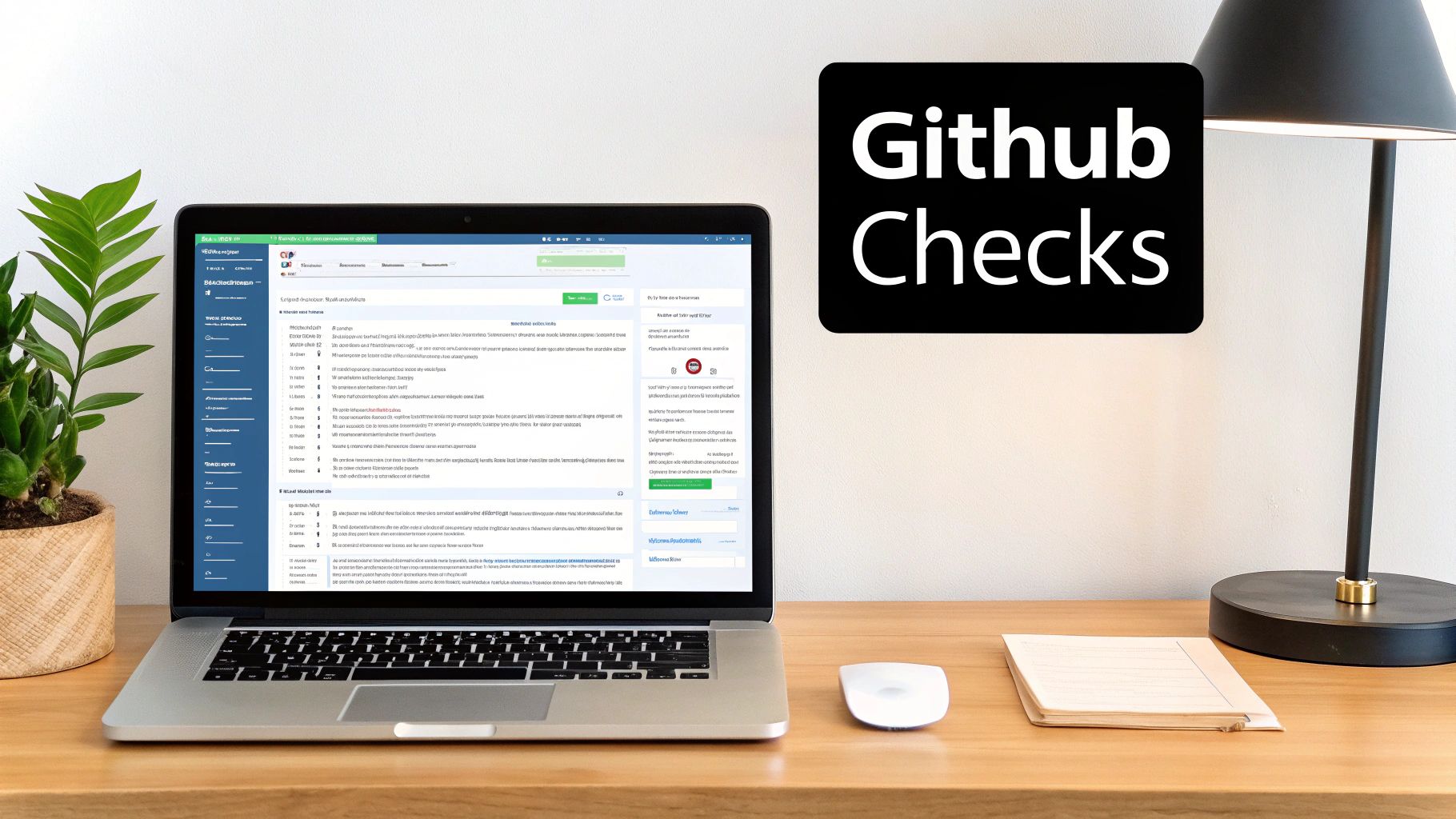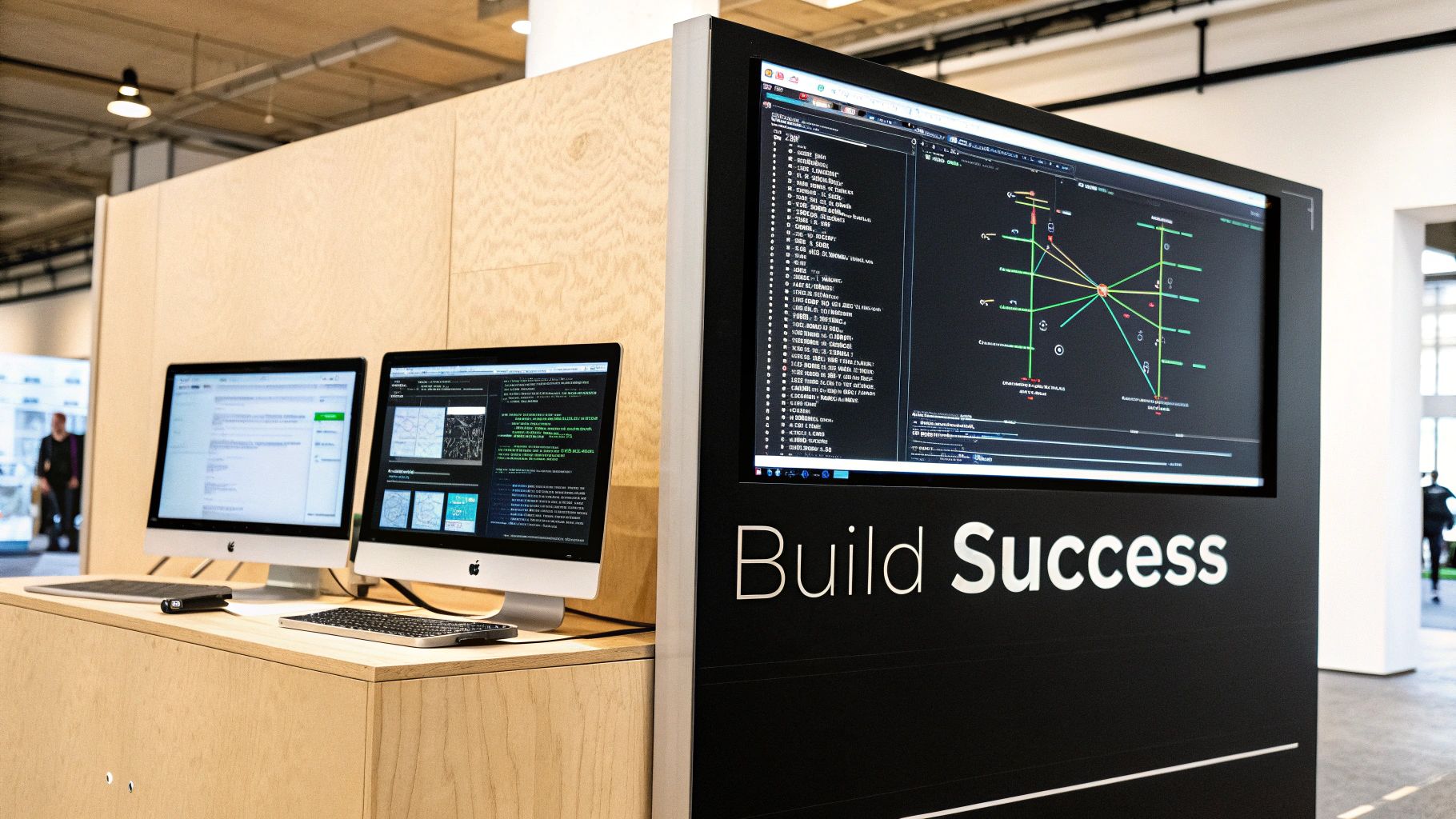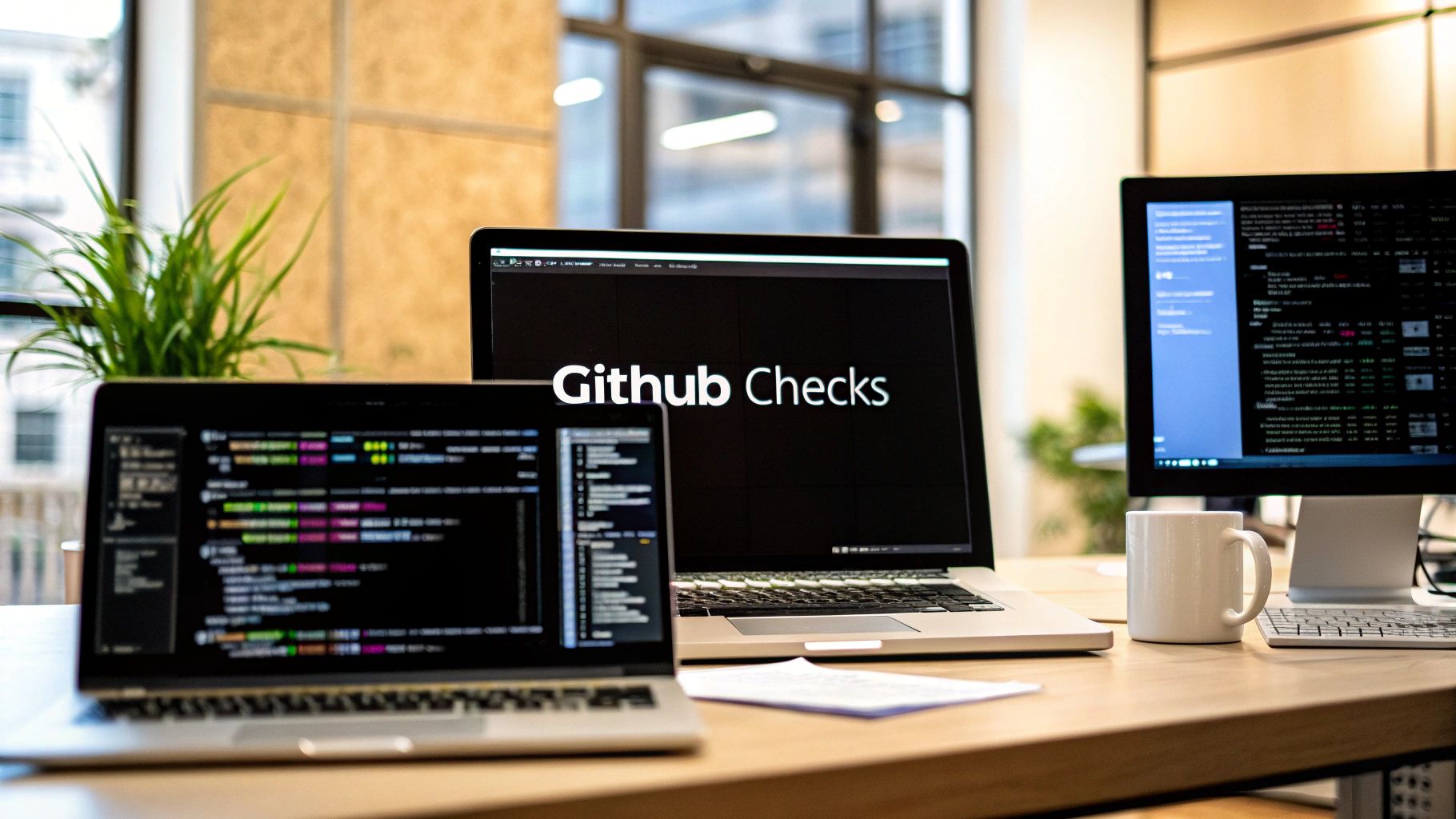Ultimate guide: github add status checks for CI success
Demystifying GitHub Status Checks for Your Workflow

In the world of software development, ensuring high-quality, reliable code is essential. GitHub status checks play a crucial role in this process. They act like gatekeepers, verifying code changes against specific criteria before integrating them into the main codebase. This helps prevent bugs and keeps your project healthy and functional.
Status checks are different from other GitHub features, such as comments or pull request reviews. They offer a more structured and automated way to evaluate your code. They can automatically trigger tests, perform code analysis, or scan for security vulnerabilities.
This automation saves developers time and reduces the risk of human error. Teams can then focus on building new features instead of manually checking every code change. Many leading development teams now incorporate status checks as essential parts of their CI/CD pipelines.
Understanding Status Check States
GitHub status checks have a few key states: success, failure, pending, and error. Each state offers critical information about your code. A success status indicates that the code passed all checks. A failure status means one or more checks failed, requiring investigation and fixes.
A pending status indicates that the checks are still running. An error status suggests a problem with the check itself, not necessarily the code. These real-time statuses offer valuable insight into the code integration process, enabling teams to address issues quickly.
These statuses also directly affect whether code can be merged. A project might require all status checks to pass before merging a pull request into a protected branch. This process ensures that only thoroughly vetted code enters the main codebase, maintaining stability and integrity.
GitHub’s status checks help ensure code quality and reliability. These checks verify that commits meet specific repository conditions. For example, they can run continuous integration (CI) builds to test changes before merging them into a protected branch. Anyone with write permissions can set the status check state, offering flexibility in managing these checks. Learn more about GitHub status checks here.
Real-World Examples and Benefits
Many teams using GitHub status checks have seen significant improvements in their development process. These include improved code quality, faster release cycles, and reduced debugging time. Status checks also help enforce coding standards and best practices across the team.
This consistency minimizes the risk of introducing technical debt and contributes to a more efficient workflow. Integrating automated checklists within pull requests adds another layer of quality control and collaboration. This comprehensive approach ensures thorough and consistent code reviews, even with a growing codebase.
The Definitive Guide to Adding GitHub Status Checks

Successfully integrating GitHub status checks into your workflow requires a clear understanding of their setup and configuration. This guide provides a step-by-step approach, ensuring code quality and streamlining your development process. We'll cover everything from the initial setup to addressing common implementation challenges.
Setting Up Status Checks
Before adding status checks, you need the right permissions. Anyone with write access to a repository can configure status checks. This access level ensures that team members responsible for code quality can effectively manage and implement these checks. This prepares the groundwork for a robust and automated code review process.
Next, prepare your repository. This involves identifying the specific checks you want to implement. Do you need checks for code style, unit tests, or security scans? Figuring out your needs upfront helps you select the right tools and configurations.
Defining Custom Status Checks
You can create custom status checks tailored to your specific requirements. This means you can define checks that perfectly align with your team's workflow and quality standards. For example, you might need a check ensuring all code follows your company's style guide.
Leveraging GitHub Actions
To implement these custom checks, you can use GitHub Actions. Actions let you automate tasks within your workflow, making them ideal for managing status checks. You can create workflows that trigger specific checks on certain events, such as pushes or pull requests. This automation increases efficiency and reduces manual overhead. For more in-depth information, check out this helpful resource: How to master GitHub status checks.
Implementing Required Checks
Protecting your main branch is critical. This is where required status checks become essential. Requiring certain checks to pass before merging code ensures only high-quality code reaches your main branch. This safeguard prevents introducing bugs or breaking changes.
Addressing Common Challenges
Implementing status checks can present challenges. One common issue is handling flaky tests. These tests provide inconsistent results, sometimes passing and sometimes failing without actual code changes. To resolve this, consider rerunning failed checks or investigating the root cause of the flakiness.
Another challenge is managing numerous status checks in large projects. As your project grows, the number of checks can become overwhelming. A clear naming convention helps keep your checks organized and manageable. This clarity lets you quickly identify and address failing checks, preventing confusion and delays.
Configuration Options and Benefits
Understanding the different configuration options is essential for maximizing the effectiveness of status checks. The following table, "Status Check Configuration Options," compares several key configurations and their benefits.
To understand the available options and how they can improve your workflow, take a look at the comparison below:
| Configuration Option | Use Case | Complexity Level | Benefits | |---|---|---|---| | Basic CI Integration | Running unit tests and linting | Low | Ensures code compiles and meets basic style guidelines | | Advanced CI/CD Integration | Deploying code to staging/production | Medium | Automates deployment pipelines and verifies code quality | | Custom Checks with GitHub Actions | Enforcing specific coding standards | Medium | Tailors checks to exact team needs | | External Service Integrations | Utilizing specialized testing tools | High | Extends check capabilities beyond GitHub's built-in features |
By understanding these configuration options, you can choose the best fit for your project, optimizing your workflow, and ensuring code quality. This careful approach creates a more robust and efficient development process. Pull Checklist can further enhance this process, streamlining and automating your pull request checklist for consistent and thorough code reviews.
Supercharging Your Workflow With GitHub Actions

Automating your GitHub status checks is key to an efficient CI/CD pipeline. GitHub Actions provides the perfect platform for this, enabling you to streamline your development process and ensure consistent quality. Leading teams increasingly rely on it to create workflows that minimize manual intervention while upholding high standards, allowing developers to focus on building features rather than repetitive testing.
Trigger Events: Optimizing Your Automation
GitHub Actions allows you to define specific trigger events to initiate your workflows. These events can range from a simple push to the repository to a pull request being opened, or even a scheduled event. Choosing the right trigger for your GitHub status checks is crucial.
For example, triggering tests on every push ensures immediate feedback on code changes. However, for larger projects, this can be resource-intensive. In those cases, triggering tests on pull requests might be a more balanced approach. Scheduled triggers are helpful for tasks like nightly builds or periodic security scans.
YAML Configurations: The Heart of Your Actions
At the core of GitHub Actions are its YAML configuration files. These files define the steps of your workflow, from code linting and unit testing to security scanning and deployment. A well-structured YAML file helps you manage complex workflows with minimal friction.
For instance, you can define multiple jobs within a workflow, each responsible for specific tasks. This modularity keeps your configurations clean and easy to maintain.
Parallelizing Checks: Boosting Performance
For projects with extensive testing, parallelizing your checks can drastically improve performance. GitHub Actions allows you to run multiple jobs concurrently, reducing the overall completion time. This is especially beneficial for complex projects with multiple dependencies.
Think of it like a restaurant kitchen: multiple chefs working on different parts of a meal simultaneously finish much faster than one chef doing everything sequentially. For more on CI/CD best practices, check out this helpful resource: How to master CI/CD pipeline best practices.
Managing Dependencies and Optimizing Usage
Managing dependencies between checks is another key aspect of effective GitHub Actions usage. You can configure workflows so that certain jobs run only after others complete successfully. This ensures a logical workflow and avoids unnecessary computations.
Optimizing your Actions usage, for both speed and cost, is also vital. GitHub tracks Actions usage, providing insights into workflow times. This visibility helps you manage usage effectively, especially regarding billing for minutes used. Learn more about GitHub Actions usage here. By carefully managing dependencies and optimizing resource allocation, you can significantly reduce the overhead of your CI/CD process.
Connecting External CI Services For Maximum Impact

Integrating external Continuous Integration (CI) services with your GitHub repositories can significantly improve your development workflow. This connection enables robust GitHub add status checks, offering immediate feedback and helping ensure high code quality. Let's explore how platforms like Jenkins, CircleCI, Travis CI, and AWS CodeBuild integrate with GitHub, maximizing the impact of your status checks.
Integrating Popular CI Platforms
Many teams use external CI platforms alongside GitHub. Linking these services creates a more thorough testing and validation process. For instance, Jenkins, a popular open-source automation server, can trigger builds based on GitHub events. This automation ensures that every push or pull request automatically starts a build and test cycle on Jenkins.
Cloud-based CI services like CircleCI, Travis CI, and AWS CodeBuild provide seamless GitHub integrations. These platforms feature pre-built integrations, simplifying the setup and allowing you to connect repositories quickly. This streamlined approach makes adding status checks to your GitHub workflow straightforward.
Authentication and Configuration
Connecting external CI services typically requires authentication. This process grants the external service access to your GitHub repository, often using API tokens or OAuth applications. Prioritizing secure authentication is vital for protecting your codebase.
After authentication, you configure the CI service to interact with your GitHub repository. This involves defining which events (like pushes or pull requests) trigger CI actions. While the configuration details vary by platform, the core principle remains the same: establishing how the CI service reacts to GitHub repository changes.
The REST API for commit statuses is essential for external service integration. It allows these services to update commit statuses (e.g., 'error', 'failure', 'pending', or 'success'). This is particularly beneficial for continuous integration, enabling direct build status reporting within GitHub. The API also provides extra details like descriptions and target URLs, giving developers detailed build results directly from GitHub. Learn more from the official documentation here.
Maintaining Consistency and Overcoming Challenges
Maintaining consistency is a key challenge when using multiple services. Your status checks must deliver clear, actionable feedback, regardless of where they run. This might require standardizing naming conventions and ensuring consistent status update reporting across all services. This consistency simplifies result interpretation and issue diagnosis.
Handling service disruptions is another important consideration. An outage in your external CI service can impact your GitHub workflow. Mitigating such disruptions, perhaps with backup CI systems or manual checks, is crucial for maintaining a reliable development process.
Practical Strategies For Enhanced Workflow
Teams successfully integrating external CI services often use specific strategies. Creating dedicated webhooks for individual checks provides granular control over which events trigger specific actions. Storing sensitive data like API keys in environment variables enhances security. Robust error handling within your CI configurations is essential, ensuring proper reporting and resolution of pipeline failures. These strategies combine to create a highly effective and reliable development pipeline, improving productivity and code quality. Connecting external CI services, coupled with these strategies, establishes a robust and well-informed development process, maximizing the value of GitHub add status checks.
Creating Bulletproof Pull Requests With Status Checks
Status checks are vital for a smooth development workflow. They act like guardrails for your pull requests, catching potential problems before they become major headaches. Top-tier engineering teams rely on these checks to set a high bar for quality across all their projects. The first step is setting up required status checks for protected branches, such as main or develop. This guarantees that all code changes go through thorough testing and review before being merged.
Managing Multiple Checks in Complex Pull Requests
Many projects require multiple status checks, covering everything from code style and unit tests to in-depth security scans and integration tests. Managing all these checks, especially in complex pull requests, is essential. One effective approach is grouping related checks. For instance, all unit tests could fall under a single "Unit Test Suite" check. This makes it easier to quickly understand the overall status.
Another useful tactic is prioritizing checks based on how critical they are. Checks that flag security vulnerabilities, for example, should be front and center. This allows developers to tackle critical problems immediately, minimizing the risk of bigger issues down the road. Visual cues, such as color-coding or badges, can also help distinguish checks by their function.
Enforcing Quality Standards With Targeted Checks
Status checks provide a way to enforce quality standards without slowing things down. Teams often use them to uphold code review standards, making sure each pull request receives a certain number of approvals. This encourages knowledge sharing and keeps the codebase consistent.
Status checks can also enforce test coverage targets. By setting a minimum percentage for test coverage, teams promote comprehensive testing and reduce the chance of regressions. They can even be used to enforce security requirements by integrating with static analysis tools like SonarQube or vulnerability scanners. This proactive approach reduces the risk of security breaches and promotes secure coding practices. You can learn more about improving your workflow with resources like How to master GitHub checklists.
Effective Communication of Status Check Failures
How teams communicate about status check failures directly affects how quickly development progresses. Instead of simply pointing out the error, helpful communication guides developers toward the solution. Clear error messages, along with links to relevant documentation or troubleshooting steps, can speed up the fixing process and make things smoother.
For example, a failed unit test status check should clearly identify the specific test case that failed and provide direct links to the code in question. This helps developers diagnose the problem quickly, without extensive debugging. Connecting status checks with communication platforms like Slack can also improve notifications and keep the team updated on the pull request status. GitHub has continuously worked to improve status check visibility. A key enhancement in December 2014 gave developers a single view of feedback from various tools. You can read more about this improvement here. Creating a clear, collaborative process around status checks reduces frustration and improves the quality of the code.
Expert-Level Status Check Strategies That Actually Work
Moving beyond simply implementing basic status checks requires a deeper understanding of what separates highly effective teams from those struggling to keep pace. This section offers practical advice from engineering leaders who've optimized their GitHub status check workflows for maximum impact with minimal friction.
Streamlining Communication With Naming Conventions
A well-defined naming convention for your status checks dramatically improves clarity across your team. Instead of cryptic, abbreviated names, use descriptive labels that clearly communicate the purpose of each check. For example, instead of CI-build, use Backend Unit Tests or Frontend Integration Tests. This simple change makes understanding the context of each check significantly easier.
Consider incorporating a prefix or suffix to categorize related checks, such as Security: or :Performance. This adds another layer of organization, making it even easier for your team to navigate the results.
Optimizing Timeout Configurations for Developer Experience
Timeout configurations are crucial, yet often overlooked. Setting timeouts too short can lead to premature failures, while overly long timeouts delay valuable feedback. The right balance is key for a smooth developer experience.
Analyze historical data on your CI runtimes to identify realistic timeout values. These should provide ample time for completion while minimizing delays. Remember to account for occasional variations in runtime to avoid unnecessary failures.
Handling Flaky Tests: A Realistic Approach
Flaky tests, those producing inconsistent results without code changes, plague CI/CD pipelines. While complete elimination is ideal, a more realistic approach minimizes their impact. Strategies like automatically retrying failed checks a limited number of times can catch transient failures without manual intervention.
If retries fail, investigate the root cause and fix the flaky test itself. This proactive approach reduces frustration and keeps your pipeline flowing smoothly.
Actionable Feedback: Guiding Developers to Solutions
Status checks should provide actionable feedback. A simple "failed" status is insufficient. Include detailed error messages, links to logs, and specific instructions for diagnosing and fixing problems.
This empowers developers to quickly identify the root cause and implement solutions, rather than simply being presented with a problem. Think of it as a helpful guide, not just a roadblock.
Scaling Your Implementation as Your Codebase Grows
As your project grows, so will the number of status checks, which can quickly become overwhelming. Plan for scalability from the start. Grouping related checks into categories or stages can improve organization and make it easier to track progress.
Consider utilizing dashboards or reporting tools to visualize overall status and identify potential bottlenecks. Periodically review and refine your checks to ensure they remain relevant and effective as your project evolves.
Continuous Refinement: Keeping Pace With Your Team
Your team’s needs will change, and your status checks should adapt. Regularly review your implementation with your team and gather feedback on effectiveness. This open communication ensures your status checks remain a valuable asset.
Consider adding new checks for emerging technologies or evolving security threats, and remove those that no longer provide value. This continuous refinement keeps your process streamlined and relevant.
To help you understand and track the key performance metrics for your status checks, refer to the table below. It outlines the target values, their impact, and how to improve them.
Status Check Performance Metrics: Key metrics to track for optimizing your GitHub status checks
| Metric | Target Value | Impact on Workflow | How to Improve | |-----------------------------|---------------------------------------------|-------------------------------------------|-----------------------------------------------------------------| | Check Runtime | As short as possible, but realistic | Developer wait time, CI costs | Optimize test suites, parallelize checks, improve infrastructure | | Failure Rate | Low (e.g., <5%) | Developer frustration, blocked merges | Address flaky tests, improve code quality | | Time to Resolution (TTR) | Minutes, not hours | Speed of development | Actionable feedback, clear documentation, automated diagnostics | | Number of Checks | Enough to ensure quality, but not excessive | Management overhead, cognitive load | Categorize checks, prioritize, automate redundant checks |
By focusing on these metrics and implementing the suggested improvements, you can streamline your workflow and reduce friction in the development process.
By implementing these expert-level strategies, you can transform your GitHub status checks into a powerful tool for ensuring code quality and fostering a more efficient development environment. Pull Checklist can further enhance this process by automating and streamlining code reviews, ensuring consistent quality across your team.
Resolving Status Check Problems Like a Pro
Even with the best configuration, GitHub status checks can sometimes be tricky. This section offers a troubleshooting guide to help you resolve common issues, from checks that fail to inconsistent results. Understanding these problems and their solutions will keep your workflow running smoothly.
Diagnosing Mysteriously Failing Checks
One of the most common frustrations is when a status check fails without a clear explanation. Your first step should be to check the logs from your CI service linked to the check. These logs are a goldmine of information and often contain clues about why the failure occurred. For instance, a log might reveal a missing dependency or a network problem during the build.
Next, investigate any recent code changes or dependency updates that might have caused the failure. Sometimes, a library update or a configuration tweak can have unintended consequences. Comparing your current code with a known working version can help identify the problematic change.
If the failure seems tied to a specific environment, compare the environments where the check passes and fails. Look for differences in configurations, software versions, or dependencies. These differences can offer valuable insights into the root of the problem.
Tackling Delayed Status Reporting
Slow status reporting can disrupt your workflow. If status updates are lagging, first check the status of your CI service itself. An outage or slow performance with your CI provider can directly impact reporting speeds.
After that, look at your workflow configurations for any bottlenecks. If a check depends on a slow external service, optimizing that dependency or finding a faster alternative might fix the delay. Similarly, long-running tests can slow things down. Think about running tests in parallel or optimizing them for speed to shorten the overall execution time.
Addressing Inconsistent Results Across Environments
Inconsistent results across different environments (like development versus production) often stem from differences in configuration, dependencies, or underlying infrastructure. Make sure all environments use the same configurations and dependency versions.
Using reproducible environments, perhaps with containerization technologies like Docker, can further reduce inconsistencies. Containerization ensures consistent behavior across different infrastructure setups.
Strategic Approaches for Bypassing Checks
In emergencies, you might need to temporarily bypass certain status checks. This shouldn't be a regular habit, but knowing how to do it safely can be helpful. GitHub lets repository administrators override required checks for specific branches. This can be crucial for urgent hotfixes or when a malfunctioning check blocks important work.
It's vital to document why the check was bypassed and make a plan to fix the underlying issue and reinstate the check as soon as possible. This maintains a balance between speed and code quality.
Maintaining Momentum Even With Challenges
Solving status check problems effectively requires proactive planning and a clear process. Set up clear communication channels for reporting and tackling issues. Connecting status checks with communication tools like Slack allows for real-time notifications and easier collaboration.
Foster a culture of continuous improvement by treating each status check failure as a learning opportunity. Regularly review your status check setup with your team and adjust it as your needs change. By mastering these troubleshooting techniques, you can quickly diagnose and resolve status check problems, keeping your team moving forward even when obstacles arise. Improve your pull request workflow and code quality with Pull Checklist, available on the GitHub Marketplace. This tool automates and manages your code review process, ensuring consistent quality and reducing manual work.
